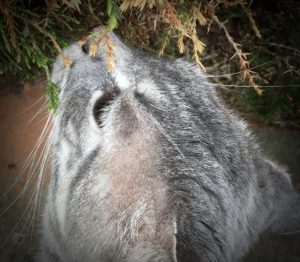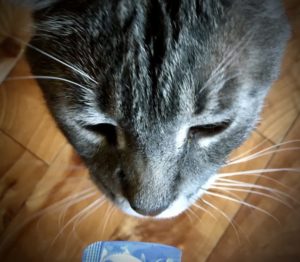
The Cat’s Whiskers
- scientific name: vibrissae
- around 24 whiskers on the muzzle
- whiskers on the backs of the forelegs and in front of the ears above the eyes
The “whisker Positioning System”
Each whisker is embedded in a cluster of nerve endings located 3 x deeper in the skin than surrounding hair follicles. Not only do whiskers alert your cat to the piece of furniture nearby, they alert him to changes in air currents, from say an open door or window.
Cats use their whiskers to navigate – whiskers help the cat pinpoint where she is relative to her surroundings – “can I fit behind this sofa?” Needless to say, a blind cat finds her whiskers crucial to getting around.

The No-See Zone
Cats are far sighted – they cannot see things that are closer than 10 inches in front of them. This is where the whiskers come into play: they can be flattened against the face or swung forward to investigate something in the “no see” zone.
Paws and Claws
Ever watched a cat walk across a narrow railing? Their sensitive paws allow them to precisely place their feet in line – they don’t have to look down, they “feel” where they are going.
Cats’ claws are sensitive to pressure – they must be able to hold and manipulate prey precisely.
Between Whiskers and Claws
Cats’ skin is very responsive to touch – they have to rub just hard enough to release pheromones when marking the corner wall with their face or when rubbing against our legs.
- Cats may not like to have their feet touched; they may react negatively to having their sensitive nails trimmed. Desensitize your cat to nail trims by proceeding slowly and rewarding him for each claw clipped.After a while he will look forward to the treat and not be so focused on the nail trim.
- Be gentle when grooming – mats in the fur coat will be uncomfortable to remove so tease the fur gently away from the skin and mat while removing it. Better yet, use clippers (quiet ones!) to shave tighter mats or seek the help of a professional groomer!
- Small children have been known to give an indulgent cat a whisker trim – keep track of the scissors when kids are around.
DID YOU KNOW:
Cats sense vibrations through their paws -they can detect our footsteps in the house through their feet!
Have you ever seen the skin along your cat’s back twitch? A muscle called the cutaneous trunci covers the cat’s back under the skin. This muscle makes the skin twitch in response to something itchy like a fly or flea. If you notice this frequently and there is no obvious cause, a visit to the vet may be in order to rule out Feline Hyperesthesia Syndrome.

